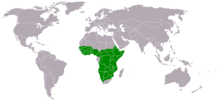Martial eagle
| Martial eagle | ||||||||||||
|---|---|---|---|---|---|---|---|---|---|---|---|---|

Male martial eagle |
||||||||||||
| Systematics | ||||||||||||
|
||||||||||||
| Scientific name | ||||||||||||
| Polemaetus bellicosus | ||||||||||||
| ( Daudin , 1800) |
The fighting eagle ( Polemaetus bellicosus ) is a bird of prey from the Aquilinae subfamily . The genus is monotypical .
habitat
The species inhabits open and semi-open landscapes in sub-Saharan Africa, from deserts to sparse forests. The distribution area extends from Senegambia in the west to Ethiopia in the east, as well as to east and southern Africa.
features
The back, neck and wings are dark brown, while the belly is colored white and spotted brown. Females are also more spotted on the chest and abdomen than males. The iris is yellow. A seated eagle has an upright posture; the head is roughly in line with its sharp claws, while the strong chest muscles are clearly visible.
The females are larger and heavier than the males; Males reach approximately 76% the size of a female. Martial eagles are 78–96 cm long, the wingspan is 188–227 cm. Weights are hardly known so far, 17 birds of undetermined sex weighed 3.01–5.66 kg.
Way of life
Martial eagle pairs live in areas of up to 250 km² . The pairs breed at intervals of about 50 km, which makes the martial eagle the bird with the world's lowest population density .
Reproduction
The breeding season lasts from November to July and shifts within this period depending on the latitude . The female builds the nest almost alone. The eyrie is built in a fork of a branch or a flat treetop and has a diameter of up to 2 m and a height of 1.5 m. When the hatchery is complete, the female lays a single beige, brown-speckled egg that weighs around 190 grams.
The young eagle hatches after a breeding period of 6 to 7 weeks. At three and a half months, the youngster makes its first attempts at flight and remains near the eyrie for a while. It finally gets its adult plumage at the age of six to seven.
food
Martial eagles mainly eat vertebrates weighing around 1 to 5 kg, namely bottom-dwelling small to medium-sized mammals ( hares , hyrax , meerkats , small antelopes or their young (such as young impala or duiker ), including jackals ) and larger birds (e. B. . fowls , waterfowl ) and reptiles ( lizards , sometimes smaller prey such as snakes and lizards ); they also take smaller pets of the same size as young goats , young sheep , dogs, and poultry.
Spread and threat
Martial eagles live everywhere south of the Sahara in Africa , except in the forest regions and on the southern tip of South Africa. Although humans are its only enemy , the martial eagle is endangered and is hunted as soon as it gets too close to settlements as many farmers fear for their livestock . A steady decline in the population can currently be observed.
literature
- J. Ferguson-Lees, DA Christie: Raptors of the World. Christopher Helm, London 2001, ISBN 0-7136-8026-1 .
- “Martial eagle.” In: Grzimek's animal life . Volume 7. Kindler Verlag, Zurich 1968, ISBN 3-463-16907-X , p. 370.
- "Genus polemaetus. " In: J. del Hoyo et alii: Handbook of the birds of the world. Volume 2. Lynx Edicions. Barcelona 1994, ISBN 84-87334-15-6 , pp. 200 f.
Web links
- Watzmann-Pictures (source of the photos used here)
- Polemaetus bellicosus in the endangered Red List species the IUCN 2008. Posted by: BirdLife International, 2008. Accessed January 30 of 2009.
- Videos, photos and sound recordings for Polemaetus bellicosus in the Internet Bird Collection
Individual evidence
- ↑ After the section in Grzimek's animal life.




